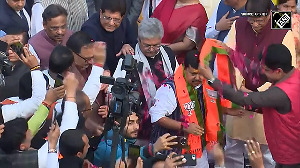The Indian tourism industry has been hit by a double whammy -- first the global slowdown and then the Mumbai attack. As a result, tourist arrivals declined for the first time in six years in November by 2.1 per cent, when compared with the same month a year earlier. This is against the good run that the tourism industry has had lately, clocking double digit growth for five years, leading to 5 million arrivals in 2007.
Having already initiated an attractive 'Incredible India' promotional campaign, the tourism ministry can do little more than request foreign governments to issue travel advisories declaring India to be a safe destination. Most of the other solutions lie at home, but they will either take long to work out or action can begin only after there is some agreement.
One effective solution is to lower luxury taxes. The tourism ministry has requested the finance ministry and the Planning Commission to work with state governments on this, but no one knows when any results will come, if ever.
In this situation, the ministry has turned to what can be done quickly and requested hotels to cut tariffs. It has the support of tour operators, who point to the fact that hotel stay accounts for the bulk of what a tourist spends and Indian hotel tariffs remain high compared to most countries, in and out of season.
The hotels are in the unenviable position of already having cut rates by as much as 30 per cent in some cases and are yet to see any improvement in their fortunes. They also point out that they are as driven by the market as any other business. As late as in October, hotels in some popular destinations were turning down bookings for January, after which of course the roof caved in.
They add that investment in hotels is lumpy and usually comes in waves, leading to periods of excess supply or demand. Their final clincher is that tariffs at popular destinations in decent properties are high primarily because land prices are high and the market for it non-transparent.
In this situation when a piece of land is auctioned, it fetches sky-high prices, making high tariffs more or less inevitable. In the last few boom years, mill land in Mumbai and plots in the national capital region and Kolkata's Eastern Bypass fetched astronomical prices.
But even within the limited space available to it, the hospitality industry can adopt a fresh approach. There is a crying need for no-frills, clean and functional budget hotels, not the Rs 5,000 ($100) per night ones that pass for them when top rates are in the Rs 12,000-15,000 range, but those that ask for closer to Rs 2,500 ($50). And here, a beginning has been made.
Indian Hotels launched four years ago the Ginger category which offers clean comfortable nights in the Rs 1,000-2,000 range, in non-metros and the outskirts of metros. Sixteen properties are up and eight more are being constructed. The company management expects these properties to break even in less than the five to seven years that top end properties take, and considers the model successful and viable.
In hospitality, as in other sectors in India, there is indeed a solution, however partial, at the middle if not the bottom of the pyramid.





